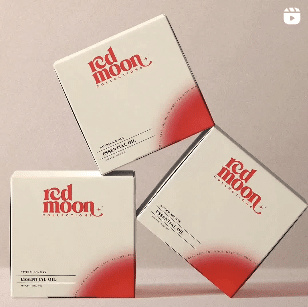Transparency is one of the precious keys to the doors of ethical branding. When a brand is transparent about its operations and activities, it demonstrates to the world that it values its customers and all those it influences – treating them with the utmost respect.
But how many companies, especially the larger ones, conduct their business as usual while keeping much information to themselves? Information such as where the products are produced, how the materials are sourced, how their prices are calculated, and so many other aspects.
While keeping some information secret is often a legitimate way to protect a company from competitors looking to replicate the same processes, providing the public with a clear view of what exactly is happening within the organization is also a golden opportunity to stand out from the crowd. It’s a chance to set a precedent, and foster trust and loyalty among consumers who appreciate a company that refrains from hiding any dubious practices.
Because it’s not always easy to figure out how to increase a brand’s transparency, we’ve curated a list of ideas that we hope will inspire you to infuse more transparency into your brand. We have included concrete, real-life examples from very different industries to make these suggestions more relatable and practical.
Table of Contents
1. Be honest about your products and services
The first idea is to provide complete information about what the brand offers, whether it is products or services. Here we are talking about:
- The advantages and drawbacks of the products and services (for example, their features, the results they offer, any potential risks, the target audience, and who may not benefit from them)
- The process of product creation (including details such as the precise composition, the source of the materials, the production process and location, and information about the suppliers and individuals involved in manufacturing them)
- Information about product disposal (including reparability, reusability, and instructions on how and where the products can be recycled).
- How the services are delivered (e.g., the methods used, the personnel involved, any third-party collaborations, the timeline and steps from initiation to completion)
Example: Fairphone, an ethical smartphone manufacturer, stands out for its commitment to transparency in product creation. They offer an interactive supply chain map, reveal information about their suppliers, and provide a detailed guide on the materials used in their phones and how they’re sourced, making the entire process visible to consumers.
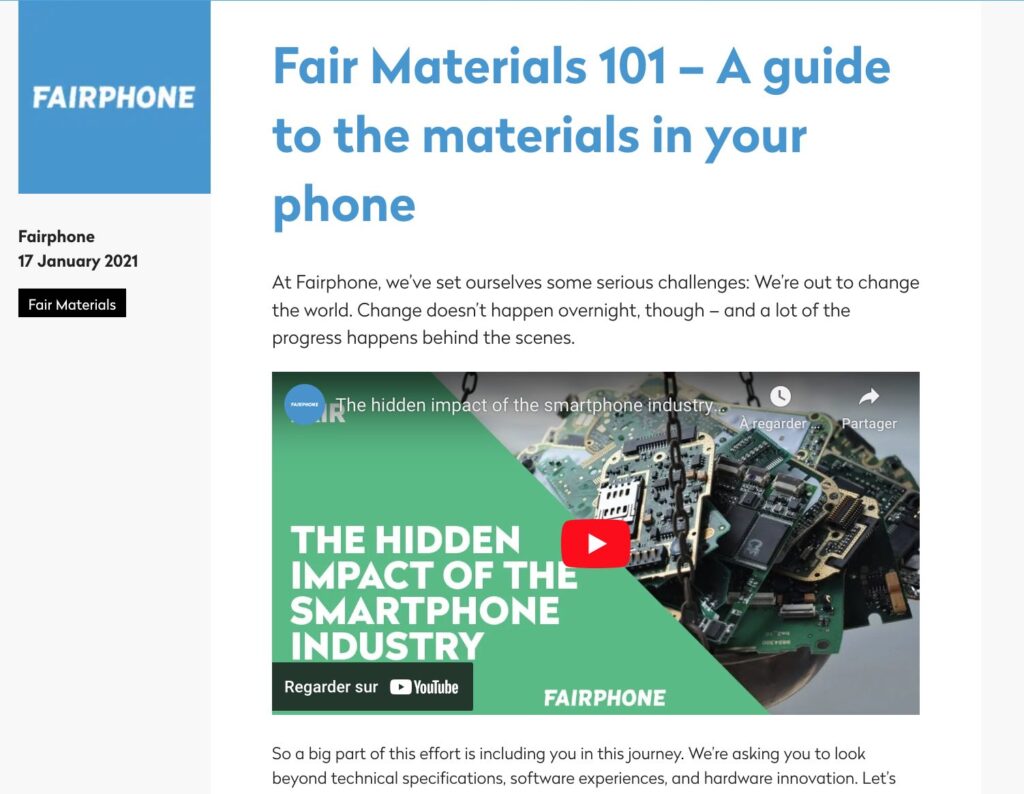

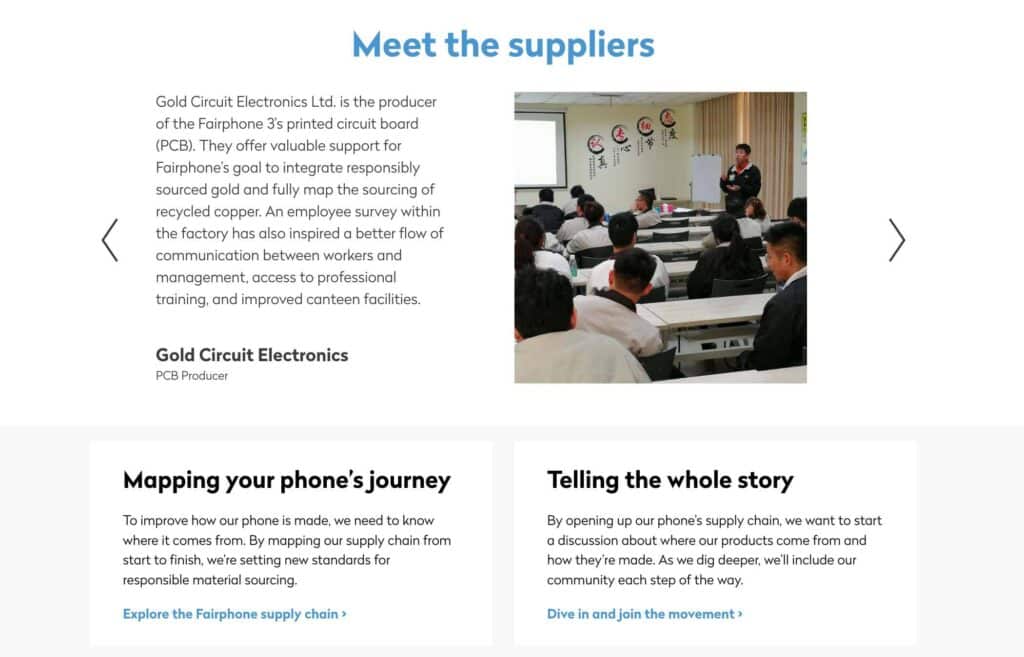
2. Explain how your prices are calculated
Another effective way to be more transparent as a brand is by publicly your pricing strategy. Customers often wonder why a product or service is priced the way it is. Detailing the cost structure, including material costs, labor, overhead expenses, and profit margins, can help them understand the value they’re getting for their money. For services, this could involve publishing precise hourly rates or prices per service and disclosing all the varied costs involved in delivering the service. Of course, sharing your pricing strategy is not an obligation, but it can be an interesting differentiator to consider in case your company is open to doing so.
Example: In 2020, Maison Cléo, a French fashion label known for its handmade clothing, disclosed the precise cost breakdown for one of its cotton blouses. The general public applauded this move, as few brands opted for such transparency. Additionally, it served as an excellent opportunity for the brand to justify its higher pricing structure and explain its rationale. Taking this transparency initiative a step further, an even more impactful approach would be to automatically provide this level of detailed cost breakdown for all their products.
3. Show behind-the-scenes images of your production process
This is a concrete example of what was mentioned in the first point of this list, and it’s worth emphasizing. Many consumers use products daily without truly understanding how they are made or what ingredients they contain. If your brand has a dedicated production facility, capturing behind-the-scenes footage showing the manufacturing process can be highly engaging.
Another idea is to organize guided factory visits, allowing people to interact with the workers and witness the production firsthand. These initiatives help foster an emotional connection between consumers and your brand’s products, as everything becomes tangible, and people gain reassurance about what they are consuming. It is also a perfect opportunity to educate and share how products are made.
Example:
Lush Cosmetics excels in showcasing the production process of its products across various countries through several YouTube videos. By sharing these behind-the-scenes glimpses, people can witness the exact steps involved in crafting their cosmetics, instilling trust and transparency.
4. Share your brand’s story
Stories have a powerful impact on how customers perceive and connect with brands. By sharing your brand’s story, you can create a relatable and human image. From humble beginnings to significant accomplishments, narrating your journey allows customers to understand your values and the events that have shaped your brand. This open sharing fosters a deep connection, as customers can relate to your struggles and celebrate your successes, creating a sense of loyalty and shared experience.
Examples: Luxury brand Chanel created a beautiful video to narrate the story of its founder, Coco Chanel. Another outstanding example is LEGO, which even created a 3D animation video to showcase the brand’s origins. However, sharing your brand’s story doesn’t always require elaborate video productions. Engaging social media posts or a well-designed webpage, like Buffer’s, can also effectively communicate your brand’s story.
5. Share your challenges (and how you are overcoming them)
Most brands tend to shy away from sharing their struggles and challenges, fearing that it may portray them as weak compared to their competition. However, consider how you would perceive someone who only shares their successes without acknowledging any obstacles they have faced – it would seem somewhat peculiar, wouldn’t it?
By openly sharing the challenges your brand encounters, you create a more relatable and human image, fostering empathy and understanding within your audience. It is crucial, however, to follow the mention of these challenges with a well-defined plan of action and potential solutions. This demonstrates the brand’s commitment to growth and improvement, showcasing a willingness to evaluate all options and make a better impact.
Example: Riverford Organic Farmers supplies organic food to 90,000 UK households. Despite primarily operating in the UK, they also have a farm in France. The founder’s video discusses challenges in sourcing local produce and explains the decision to have a farm in France, even though it may seem contrary to their sustainability commitments. The content is insightful, and many customers have appreciated the honesty in the comments section.
6. Create spaces for dialogue
Creating a space for dialogue is an essential aspect of fostering brand transparency. Brands that value and actively address customer feedback, both positive and negative, demonstrate a genuine commitment to openness.
Creating communication channels like a direct email or phone number for customer support, virtual suggestion boxes, live Q&A sessions, and in-person meetings shows brands’ genuine care for customer opinions and experiences. These interactions also reveal the people behind the brand, increasing transparency. Engaging in dialogue allows brands to address concerns, gather insights, and demonstrate a commitment to improvement. This reassures customers that their voices matter, strengthening the brand-customer relationship.
Example: Integrately, an all-in-one integration platform, also provides users with a virtual and public suggestion box to gather feedback and feature requests. Known as the “Integrately Feature Request Box,” this platform allows users to submit their ideas, suggestions, and feedback to enhance the functionality and user experience of Integrately. Users can also view popular feature requests and the Integrately team’s plans for implementation, highlighting their commitment to transparency.

Another similar example is this German marketplace to sell and buy websites where they implemented a so-called “Ideenboard” (idea board). Here they ask users for ideas and feedback to improve the platform.
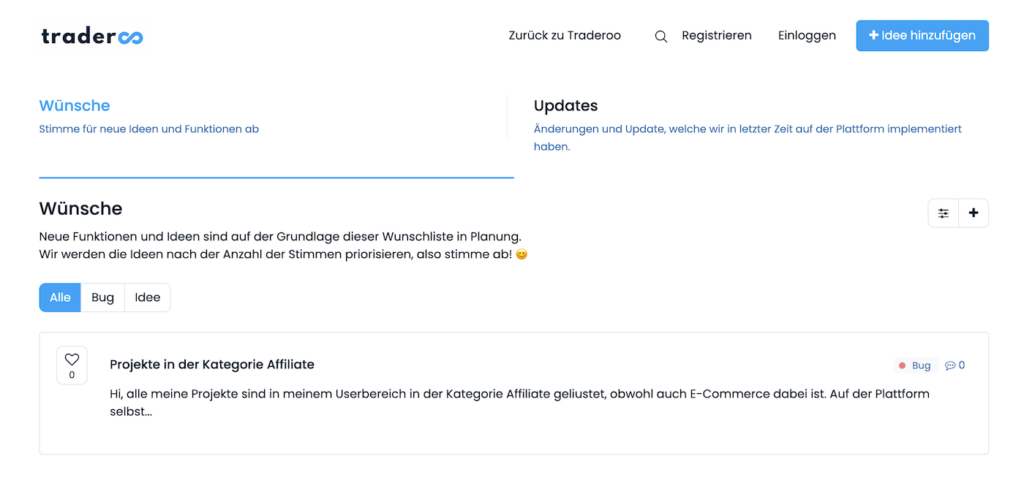
7. Enhance transparency through report publication
Publishing reports, such as financial, HR, and sustainability reports, offers visibility into a brand’s financial health, business operations, employee well-being, and sustainability practices. Financial statements showcase transparent business operations and performance, while HR reports demonstrate a commitment to a positive work environment and inclusivity. Sustainability reports outline the brand’s environmental and social impact, displaying dedication to improvement in these areas.
Overall, publishing this type of information demonstrates openness, accountability, and a commitment to transparency in various aspects of a brand’s operations. While often optional for small companies, these reports allow them to showcase their commitment to transparency.
Example: Tony’s Chocolonely, a fair trade chocolate brand, has consistently released annual reports that provides information on their financial performance, supply chain transparency, and efforts to combat child labor and slavery in the cocoa industry. The reports are complete and designed uniquely, in alignment with the brand’s visual identity.
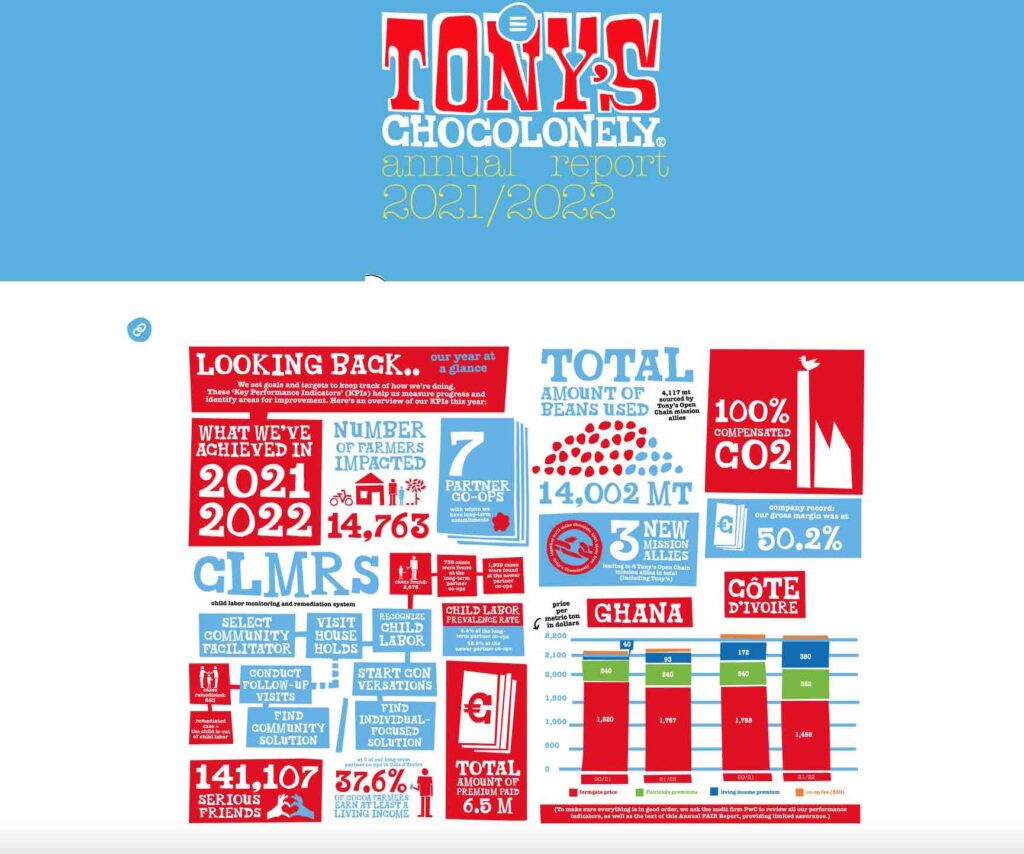
8. Communicate policy updates clearly
How often have you received company notifications or emails regarding updates to their Privacy Policy or Terms of Service? And how often have you taken the time to read them thoroughly?
In our fast-paced lives, such reading can often be challenging. However, these updates can significantly impact your rights in using a service or purchasing a product.
When sharing policy updates, it is crucial to consider the perspective of your brand’s customers, employees, and other affected individuals. Put yourself in their shoes and strive to make their lives easier. Consider including a summary of the changes, clearly explaining their implications. Temporary inclusion of the previous version of the document enables easy comparison with the new version. Additionally, provide detailed instructions on what to do if individuals disagree with the changes, such as how to delete their account. By prioritizing clarity and user-friendliness, you can effectively communicate policy updates and ensure everyone understands their rights and options.
Example:
Indiegogo, an American crowdfunding platform, exemplified transparency by issuing a concise newsletter before the implementation of GDPR. They summarized the changes in three bullet points and included links to previous policies for easy comparison.
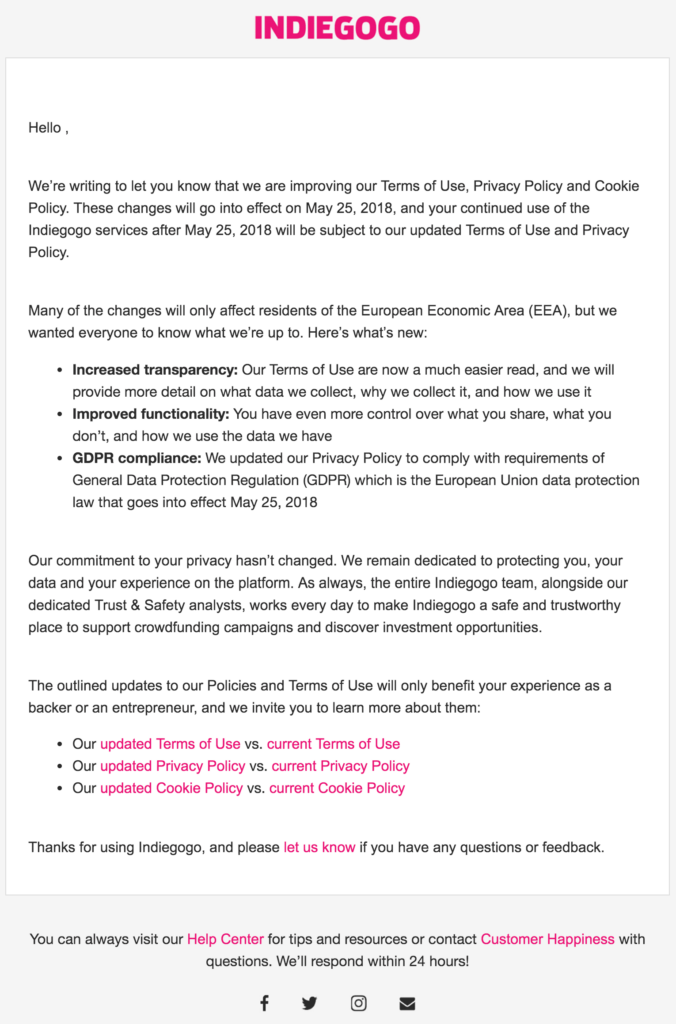
9. Spotlight your brand’s people
When we think of brand transparency, it typically revolves around being open with consumers. However, a brand impacts various individuals and stakeholders, including employees, suppliers, investors, and local communities.
From an employer branding perspective, showcasing the people behind your brand and highlighting select employees, with their consent, of course, can be valuable. You can allow them to become brand ambassadors, sharing videos of them on social media, highlighting their achievements, explaining their roles within the brand, or even sharing their experiences as employees through the ‘Career’ section of your brand’s website.
The possibilities are endless, offering an excellent chance to humanize the brand and showcase the dedicated individuals who make it all possible.
Example:
Adobe’s dedicated YouTube Channel for Careers is a treasure trove of video interviews featuring their global employees. This platform is a perfect glimpse into the offices and the people who contribute to the Adobe brand. Additionally, it offers valuable insights into the experience of working for the company.
10. Share work-in-progress projects
As the final idea on this list, why not consider sharing the projects your brand is currently working on, even if they are not finalized? While there is a risk of discussing projects that may not ultimately come to fruition, sharing those that are highly likely to materialize can be incredibly engaging for your consumers.
Why? Because sharing upcoming projects creates a sense of exclusivity as if you are sharing a secret privilege with your audience. It also builds trust and anticipation for the project’s launch. Lastly, it is an opportunity to showcase the brand’s direction and overall activities, as completed projects represent only a tiny portion of the bigger picture.
Few organizations take this approach, offering another chance to stand out through transparency and differentiate the brand.
Example:
Sway The Future is an innovative start-up that produces regenerative packaging from seaweed intending to replace plastic. Initially started as a design studio and materials lab, the two founders have consistently shared their journey, goals, projects, and knowledge mainly through their Instagram account. An inspiring example to end the list!
Key takeaways
To recap, here is the list of 10 ideas to foster transparency in your brand:
- Be honest about your products and services
- Explain how your prices are calculated
- Share behind-the-scenes images of your production process
- Tell your brand’s story
- Share your challenges and how you are overcoming them
- Create spaces for dialogue
- Publish reports to enhance transparency
- Highlight your brand’s people
- Clearly communicate policy updates
- Share work-in-progress projects
Remember, transparency requires an ongoing commitment to consistency, honesty, and ethical practices. These are just a few examples, and there are numerous creative ways to demonstrate transparency.
By implementing some or all of these ideas, you will gradually build trust with your customers and cultivate their loyalty towards your brand.
Cover image: Kelly Sikkema








